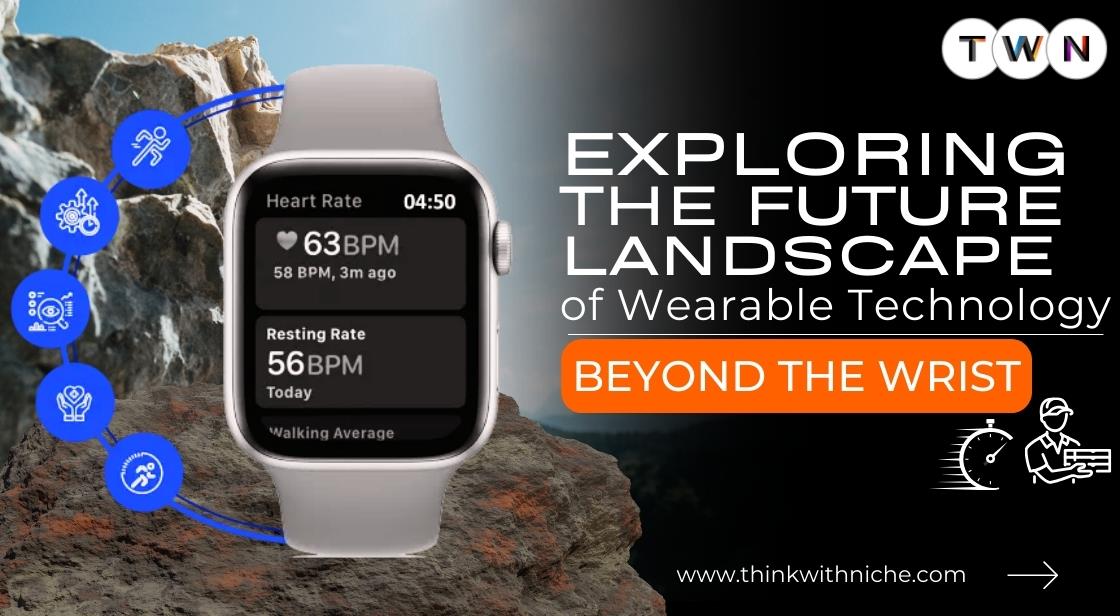Exploring the Future Landscape of Wearable Technology: Beyond the Wrist

Blog Post
In the ever-evolving landscape of technology, wearables have emerged as a transformative force, transcending their conventional role as mere accessories to becoming indispensable tools enhancing various aspects of our lives.
As we delve into the future of wearable technology, we find ourselves moving beyond the confines of the wrist, exploring new frontiers and possibilities that promise to reshape how we interact with and perceive technology.
The traditional image of wearable devices primarily consisting of smartwatches and fitness trackers is rapidly expanding, giving rise to a diverse array of innovations across multiple domains.
From smart clothing embedded with sensors to augmented reality (AR) glasses delivering immersive experiences, the boundaries of wearable technology are continuously being pushed, fueled by advancements in materials science, miniaturization, and connectivity.
Beyond serving as convenient gadgets, these next-generation wearables are poised to revolutionize industries ranging from healthcare and fitness to entertainment, education, and beyond. Imagine a future where your clothing not only keeps you warm but also monitors your health in real-time, alerting you to potential health risks before they escalate.
Picture a workplace where employees seamlessly interact with digital information overlaid onto their physical surroundings through sleek AR glasses, enhancing productivity and collaboration.
Moreover, the integration of artificial intelligence (AI) and machine learning algorithms into wearable devices is unlocking unprecedented levels of personalization and predictive capabilities, further blurring the line between human and machine interaction.
As we embark on this journey into the future of wearable technology, it becomes increasingly clear that the potential applications and implications are as limitless as our imagination. In this exploration beyond the wrist, we are not just witnessing the evolution of gadgets but the dawn of a new era in human-computer interaction, where technology seamlessly integrates into the fabric of our daily lives, enhancing our capabilities and experiences in ways previously unimaginable.
The Future of Wearable Technology Explored: From Gadgets to Garments
Introduction to Wearable Technology
Definition of Wearable technology:
Wearable technology encompasses devices or gadgets worn by users, typically incorporating sensors and connectivity to gather and exchange data seamlessly.
Historical Background of Wearable technology:
Wearable technology has evolved significantly over time. It began with early inventions such as wristwatches, which provided a convenient way to tell time. Gradually, wearable devices advanced to include more functionalities, leading to the development of modern-day smartwatches, fitness trackers, and other sophisticated gadgets. These innovations have revolutionized how we interact with technology, offering new levels of convenience, connectivity, and functionality.
Current State of Wearable Technology
Overview of Existing Devices:
Smartwatches:
Apple Watch: Leading the market with its extensive health tracking features, app ecosystem, and sleek design.
Samsung Galaxy Watch: Offering a variety of fitness tracking functionalities, customizable watch faces, and compatibility with Android smartphones.
Fitness Trackers:
Fitbit: Known for its accurate activity tracking, heart rate monitoring, sleep analysis, and user-friendly interface.
Garmin: Popular among athletes for its advanced GPS tracking, long battery life, and robust sports-specific features.
Smart Glasses:
Google Glass: Initially targeted at developers and enterprise applications, offering hands-free access to information through a small display.
Snapchat Spectacles: Focused on capturing and sharing first-person videos, integrating with Snapchat for social sharing.
Market Analysis:
Current Market Size:
The wearable technology market is growing rapidly, with a global market size projected to reach billions of dollars. Factors driving growth include increasing health consciousness, technological advancements, and expanding applications beyond fitness.
Key Players:
Apple, Samsung, Fitbit, Garmin, and Xiaomi are among the leading companies in the wearable tech market. Emerging players include Huawei, Fossil, and startups focusing on niche segments like smart clothing and hearables.
Consumer Adoption Trends:
Wearable devices are becoming more mainstream, with a shift from early adopters to mass-market consumers. Health and fitness remain primary drivers of adoption, but there's growing interest in smartwatches for notifications, productivity, and style.
Use Cases:
Healthcare:
Monitoring vital signs, detecting anomalies, and managing chronic conditions through continuous health tracking. Telemedicine integration for remote patient monitoring and virtual consultations.
Fitness:
Tracking activity levels, workouts, and sleep patterns to encourage healthier lifestyles. Providing personalized coaching and feedback to improve fitness performance.
Gaming:
Augmented reality (AR) and virtual reality (VR) experiences through smart glasses for immersive gaming. Integrating biometric feedback for enhanced gameplay and emotional engagement.
Fashion:
Blending technology with fashion through stylish wearables like smart jewelry, rings, and accessories. Customizable watch faces and interchangeable bands to match different outfits and occasions.
Workplace Productivity:
Hands-free access to notifications, reminders, and calendar events through smartwatches. Enhanced communication and collaboration in industries like logistics, field services, and manufacturing through AR smart glasses.
Also Read: How Technology is Redefining the Future of Media Landscape?
Innovations Driving the Future of Wearable Technology
Advanced Sensors
Biosensors for Health Monitoring: Advancements in biosensor technology allow for real-time monitoring of vital signs such as heart rate, blood pressure, and even biochemical markers like glucose levels.
Environmental Sensors for Pollution Detection: Wearable devices equipped with environmental sensors can detect pollutants in the air, providing users with information about air quality and potential health risks.
Gesture Recognition Sensors for Intuitive Interaction: Gesture recognition sensors enable users to interact with wearable devices through simple hand movements or gestures, enhancing user experience and usability.
Miniaturization
The miniaturization of components enables the development of smaller, sleeker wearable devices that are more comfortable to wear for extended periods. Smaller components also contribute to enhanced functionality by allowing for the integration of multiple features into compact designs.
Flexible Displays
Flexible OLED and E-Ink Displays: The emergence of flexible OLED and e-ink displays enables the creation of wearable devices with curved screens and wraparound designs. Flexible displays offer improved durability and versatility, allowing for innovative form factors and better user experiences.
Integration with AI
Personalized Insights: Integration of AI and machine learning algorithms enables wearable devices to analyze user data and provide personalized insights into health, fitness, and productivity.
Predictive Analytics: AI-powered wearables can anticipate user needs and behaviors, offering predictive analytics to help users make informed decisions and take proactive measures for their well-being.
Connectivity
Role of 5G and IoT Connectivity: 5G and IoT connectivity play a crucial role in enabling seamless communication between wearable devices and other connected devices such as smartphones, smart home appliances, and healthcare systems.
Enhanced connectivity facilitates real-time data sharing, remote monitoring, and synchronization across multiple devices, enhancing the overall user experience.
Energy Efficiency
Innovations in Energy-Efficient Components: Advances in energy-efficient components such as low-power processors, sensors, and display technologies help extend the battery life of wearable devices.
Battery Technologies: Ongoing research in battery technologies, including advancements in lithium-ion batteries and the exploration of alternative power sources such as solar and kinetic energy, aims to further improve the energy efficiency and longevity of wearable devices.
Emerging Trends in Wearable Technology
Health and Wellness Monitoring
Real-time health monitoring: Wearable devices now offer real-time tracking of vital signs such as heart rate, blood pressure, and blood oxygen levels, providing users with instant insights into their health status.
Sleep tracking: Many wearables incorporate sleep tracking features, analyzing sleep patterns and providing recommendations for improving sleep quality.
Stress management: Wearables equipped with stress-monitoring capabilities use metrics like heart rate variability to assess stress levels and offer relaxation techniques or mindfulness exercises to help users manage stress.
Personalized fitness coaching: Advanced wearables use data analytics and machine learning algorithms to provide personalized fitness plans, track workouts, and offer feedback to users, enhancing their exercise routines.
Augmented Reality (AR) Glasses
Digital information overlay: AR glasses overlay digital content onto the user's real-world environment, enhancing experiences in gaming, navigation, and remote assistance.
Gaming: AR glasses enable immersive gaming experiences by overlaying game elements onto the physical environment, creating interactive and dynamic gameplay.
Navigation: AR glasses provide heads-up displays of navigation instructions, points of interest, and real-time information about the surrounding environment, making navigation more intuitive and convenient.
Remote assistance: AR glasses facilitate remote collaboration by allowing users to share their perspective with others and receive real-time guidance or instructions, benefiting industries like manufacturing, maintenance, and telemedicine.
Smart Clothing
Embedded sensors and conductive threads: Smart textiles and clothing incorporate sensors and conductive threads to monitor biometric data such as heart rate, body temperature, and movement patterns.
Biometric data monitoring: Smart clothing continuously monitors biometric data to provide insights into physical performance, detect early signs of fatigue or injury, and optimize training regimens.
Temperature regulation: Some smart textiles use thermoregulation technology to adjust body temperature by actively cooling or heating the fabric, enhancing comfort and performance during physical activities.
Athletic performance enhancement: Smart clothing analyzes biometric data in real-time to provide feedback on posture, form, and muscle activity, helping athletes optimize their performance and reduce the risk of injuries.
Brain-Computer Interfaces (BCIs)
Direct brain-device communication: BCIs establish direct communication pathways between the brain and external devices, enabling applications such as mind-controlled prosthetics, gaming interfaces, and communication devices.
Mind-controlled prosthetics: BCIs interpret neural signals to control prosthetic limbs, restoring mobility and independence to individuals with limb loss or paralysis.
Gaming: BCIs enable immersive gaming experiences by translating brain activity into game commands, allowing players to interact with virtual environments using their thoughts.
Communication: BCIs offer communication solutions for individuals with severe disabilities by translating brain signals into speech or text, providing them with alternative means of expression and interaction.
Personalized Healthcare
Continuous monitoring of chronic conditions: Wearable devices enable continuous monitoring of chronic conditions such as diabetes, hypertension, and respiratory disorders, allowing for early detection of abnormalities and timely interventions.
Early disease detection: Wearable sensors and algorithms can detect subtle changes in biometric data patterns associated with various diseases, facilitating early diagnosis and treatment.
Remote patient monitoring: Healthcare providers use wearable devices for remote patient monitoring, enabling proactive management of patients' health conditions and reducing the need for frequent hospital visits.
Fashion-Tech Collaboration
Stylish wearable devices: Fashion brands collaborate with technology companies to design wearable devices that blend fashion and functionality, seamlessly integrating into users' everyday lives.
Integration of technology: Fashion-tech collaborations focus on integrating technology discreetly into clothing and accessories, ensuring that wearable devices are both stylish and practical.
Consumer appeal: By combining fashion aesthetics with cutting-edge technology, these collaborations appeal to a wider audience, encouraging adoption of wearable devices as fashion accessories rather than just gadgets.
Also Read: What are the Top 10 AI Trends that will Reshape 2024 and Beyond?
Challenges and Considerations
Privacy and Security Concerns
Data Privacy: Wearable technology collects sensitive personal data, raising concerns about who has access to this information and how it's used.
Security Breaches: Vulnerabilities in wearable devices can lead to data breaches, exposing users to identity theft or other malicious activities.
Ethical Implications: The ethical dilemma arises from the potential misuse of personal data by companies or third parties, leading to issues such as discrimination or manipulation.
Challenges in User Experience
User Interface Design: Designing intuitive interfaces for small screens and limited interaction methods can be challenging, affecting user satisfaction and engagement.
Battery Life: Short battery life is a common issue, requiring frequent recharging and impacting the device's usability and convenience.
Comfort: Wearable devices must be comfortable to wear for extended periods to encourage continuous usage and minimize user discomfort.
Accessibility: Ensuring accessibility features such as voice commands or larger font sizes is crucial for users with disabilities to fully utilize wearable technology.
Regulatory Compliance Requirements
Safety: Regulations are necessary to ensure that wearable devices comply with safety standards to prevent harm to users.
Reliability: Standards for reliability and accuracy are essential, particularly for wearable healthcare devices, to guarantee reliable data for medical purposes.
Accuracy: Accuracy standards are crucial for ensuring that data collected by wearable devices, especially those used in healthcare, is dependable for diagnosis and treatment.
Affordability and Accessibility Challenges
Cost: The high cost of wearable technology can limit access, especially for underserved populations and those in developing countries.
Accessibility: Ensuring that wearable devices are available and affordable to all socio-economic groups is essential for equitable access to technology and its benefits.
Environmental Impact Considerations
E-Waste Generation: The disposal of obsolete wearable devices contributes to e-waste, posing environmental hazards if not properly managed.
Energy Consumption: Wearable devices require energy to function, and optimizing energy efficiency can reduce their environmental footprint.
Sustainable Manufacturing: Adopting sustainable manufacturing practices, such as using eco-friendly materials and reducing waste, is vital for mitigating the environmental impact of wearable technology.
Addressing these challenges and considerations requires collaboration among technology companies, policymakers, and stakeholders to develop solutions that prioritize privacy, usability, compliance, affordability, and environmental sustainability.
Future Outlook and Potential Applications
Health and Medical Applications
Wearable devices can provide continuous monitoring of vital signs, allowing for early detection of health issues and personalized treatment plans. They can track physical activity, sleep patterns, and dietary habits, enabling individuals to make informed decisions about their health and lifestyle.
Wearables can facilitate remote patient monitoring, reducing the need for frequent hospital visits and improving access to healthcare, especially in rural or underserved areas.
Workplace Productivity
Augmented reality (AR) glasses can overlay digital information onto the physical environment, providing workers with real-time instructions and data visualization. Hands-free communication devices can streamline communication in busy work environments, improving efficiency and reducing distractions.
Wearables with sensors can collect data on employee productivity and workflow, helping employers optimize processes and identify areas for improvement.
Entertainment and Gaming
Wearable VR headsets offer immersive gaming experiences, transporting users to virtual worlds and enhancing gameplay with motion tracking and haptic feedback. Interactive storytelling platforms use wearables to engage audiences in immersive narratives, blurring the lines between fiction and reality.
Wearable devices can track biometric data, allowing game developers to create personalized gaming experiences based on the player's emotional and physical responses.
Education and Training
Language learning apps with wearable translation devices can provide real-time language assistance, helping users communicate in foreign languages more effectively. Wearable sensors can track movements and provide feedback during skill-based training activities, such as sports coaching or music lessons.
Immersive simulations using AR or VR headsets can recreate realistic training scenarios, allowing learners to practice complex tasks in a safe and controlled environment.
Social Impact
Wearable technology can enhance accessibility for individuals with disabilities, providing assistive features such as voice commands, text-to-speech, and haptic feedback. Inclusive design principles can ensure that wearable devices accommodate diverse user needs and preferences, promoting equity and diversity in technology adoption.
Wearables can empower marginalized communities by providing access to information, resources, and support networks, fostering social inclusion and empowerment.
Ethical and Societal Implications
The widespread adoption of wearable technology raises concerns about data privacy and security, as wearable devices collect and transmit sensitive personal information.
Surveillance capabilities inherent in some wearables raise questions about individual autonomy and consent, prompting debates about the balance between convenience and privacy.
The digital divide may exacerbate existing inequalities, as access to wearable technology and digital literacy skills varies across socioeconomic and geographic lines, highlighting the need for equitable technology access and education initiatives.
Importance of Wearable technology:
Wearable technology holds immense significance in various aspects of modern life. Firstly, it enhances convenience by providing users with quick access to information, notifications, and services directly from their wrists or clothing. Additionally, wearable devices play a crucial role in health monitoring, allowing individuals to track their fitness goals, monitor vital signs, and manage chronic conditions more effectively.
Moreover, wearable tech contributes to increased productivity by streamlining tasks, providing real-time data insights, and facilitating hands-free communication. Lastly, wearable devices also offer entertainment value, with features such as music playback, gaming, and immersive experiences, adding to their appeal and utility in everyday life. Overall, wearable technology has become an integral part of our lives, offering a multitude of benefits across various domains.
Conclusion
Summarize the main innovations, trends, challenges, and potential applications discussed in the paper. Highlight the transformative potential of wearable technology in shaping the future of healthcare, communication, entertainment, and daily life. Encourage further research, innovation, and collaboration to address challenges, maximize opportunities, and ensure the responsible development and adoption of wearable technology for the benefit of society.
You May Like
EDITOR’S CHOICE












